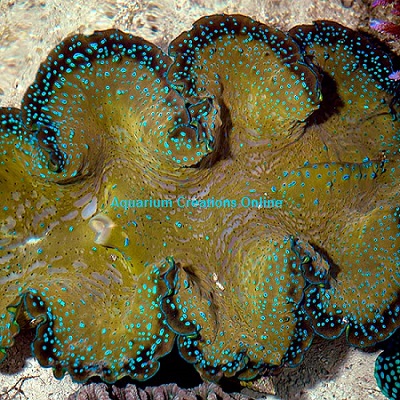
|
|
|
|
|
|
|
|
|
|

Gigas Clams Return to the Reef Hobby!
|
The true giant clam, Tridacna gigas, is after 10 long years making a return to aquariums around the world. Aquarium Creations grading system for clams is Normal Grade, Ultra Grade and Best Pick. Best Pick Gigas Maxima Clams must have that extra something, they are extremely beautiful specimens in a sea of beautiful specimens. They are the best of the best..
|
| Approximate Size | 1-3/4" to 2-1/2" | ||
|---|---|---|---|
| Grade | Normal Grade | Ultra Grade | Best Pick |
| Price | $199.99 | $239.99 | $349.99 |
|
All of the clams species in the Tridacnid family are commonly called giant clams. They all grow quite large. But the largest of the large is the Tridacna gigas clam. The real giant commonly reaches a size that will Dwarf it's relatives. The Gigas clam commonly reaches well over two feet long. Want to know what the record is? How about four and a half feet from end to end! The Tridacna gigas is a hardy and great looking clam, but they require a well established large tank, good lighting and good water chemistry. But, for those with large tanks (and very bright lights), the Gigas clam can certainly be a breathtaking addition to your tank. Water Flow: The gigas can be exposed to low flow, but they don't appreciate strong non-stop linear current. Watch their extended soft tissue, if its mantle is always pulled into its shell, if it folds upwards often or folds over onto itself all the time, do something about it. Clam Placement: When a Gigas clam is small in size they try to attach themselves to a hard bottom. Sp place on a hard surface. When they get large enough to support themselves they will release and stay positioned from their own weight. Lighting: The Gigas Calm needs bright lights in order for the zooxanthellae to do their job too, so proper lighting is critical. We recommend either metal halide lighting or strong LED lighting. Feeding: As long as you have good lighting, and a good number of fishes to create particulate food for your gigas, there shouldn't be a need to add food like phytoplankton. That's not to say that your clams won't benefit from extra food, it just means it may not be necessary. So How Large A Tank DO I need? OK so needles to say Gigas grow fast, and obviously get big. Under optimal conditions, the gigas clam without a doubt is the fastest growing of the giant clams, terrific if you already own a large tank, not so great if you have a relatively small tank and have to go buy a bigger one every so often. Keep in mind that if you plan on having a gigas long term, it is smart to immediately get a tank that is at least 18 inches wide so you can set it up only one time. Water Chemistry: Keep calcium levels 380 to 450 mg/L, alkalinity levels between 8 to 11 dKH, and the tanks magnesium level between 1280 to 1350 ppm. Acclimation: Slowly acclimate the clam to your water conditions (drip acclimatisation is best, over the course of around an hour) and then place the clam as low down in the tank as possible, gradually moving it higher over 2 week time periods. It is important that it is not moved repeatedly over less a period of time unless you absolutely have to. Clams have a lot of trouble adapting to changes in lighting and current as it is, and moving them over and over again in shorter time periods can prove very stressful. Care Level: Moderate. Tridacna Gigas are a relatively hardy clams as long as they receive the required strong lighting, proper water chemistry and good water flow. |
|
Copyright 2018 Aquarium Creations Online. While Aquarium Creations does its best to make an accurate representation of marine life on our website there is no guarantee that the actual marine life delivered will match the colors seen on your computer. Often the color reproduction on a computer screen or mobil device may not be produce the correct colors. |